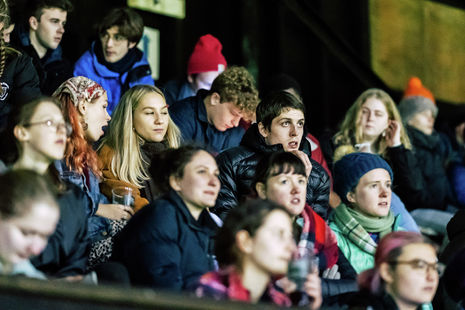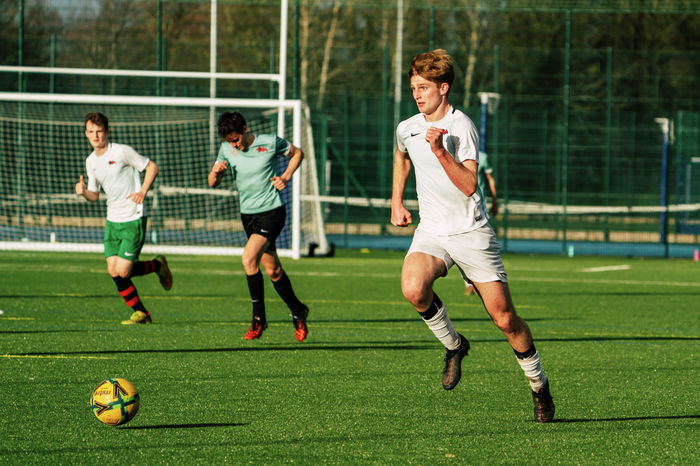University sport in Britain: a vicious cycle of poor attendance
Lamenting the small crowds at big university sports fixtures, Louis Burrows takes a look at why this problem exists in the first place and how it can be fixed

I have a number of friends baffled by my use of the first person when describing the success (and failure) of my beloved Ipswich Town FC. “Were you playing?” is the common response. “Do you own the team?” is another favourite. I proceed to launch into an hour-long tirade as to the importance of a football club to its local community, the sense of belonging it provides, and the numerous studies showing the positive effects of sports fandom. They remain unconvinced.
Yet here, at university, we are presented with an option to rebut such opinions once and for all. I speak, of course, about the university sports teams. The clubs that, skill notwithstanding, every student can join and represent. The teams that we have indisputable ties to, and whose successes can be worn as badges of honour by the institution as a whole. Why then, do our teams struggle to attract more than a handful of spectators for even the most prestigious of fixtures?
In little over a month, Cambridge United’s 8000-capacity Abbey Stadium will play host to the Varsity Football Match. This is a fixture that has been played for almost 150 years between two of the biggest rivals in university sport and yet, at the time of writing, will likely struggle to fill a single stand. The Varsity Rugby Match tells a similar story, which, despite being held at the home of English rugby, has frequently failed to attract many more than 20,000 spectators in recent years – around a quarter of Twickenham’s capacity.
“Our institutions are packed with elite sportspeople, which is why it is so strange that, as a country, we cannot seem to figure out how to translate that into audience figures”
To further drive it home, these are generally the upper bounds of attendances for university sport. Few other fixtures outside of Oxbridge rivalry receive any such attention. Loughborough’s women’s rugby side plays in the highest division in the country and boasts England internationals, yet often struggles to receive attendances over the 500 mark. Cardiff Metropolitan University’s football team played in the UEFA Europa League qualifiers in 2019 and, even then, could only attract an attendance of 1300. Despite making it to the third round of the Scottish Cup in 2018, alongside teams in the Scottish Championship, Stirling University only managed to garner an audience of 395 for arguably their biggest ever fixture.
If we compare the UK’s approach to that of the USA, we must look at the University of Michigan, which regularly attracts over 100,000 spectators to its American football matches and, for one match in 2021, drew over 15 million viewers on TV. In fairness, this is like comparing apples and oranges. The American university sports system is set up as a direct pathway to the draft of the professional leagues and, in a country dominated by a franchise model for sports, the National Collegiate Athletic Association (NCAA) is the closest thing America has to a second tier. Nevertheless, there are lessons to be learnt regarding how to make university sport appealing en masse.
“It would be ludicrous to suggest a move towards a fully Americanised system, where universities act as the second tier of sport”
To be clear, such remarks are not designed to cast shame upon sports at British universities – far from it. These remarks aim to dispel the myths about university sport being of a poor standard. Our institutions are, as demonstrated above, packed with elite sportspeople, which is why it is so strange that, as a country, we cannot seem to figure out how to translate that into audience figures.
It’s clear, however, that both the organisers and universities want this to change. In 2018, BUCS, the governing body for higher education sport, organised a broadcasting deal with FreeSports to show games from their Super Rugby competition and, whilst the deal was scrapped after that season due to poor viewing figures, many Super Rugby games continue to be broadcast to a high standard on platforms like YouTube. Recently, this model has been adopted more widely by individual universities, including Cambridge, to attempt to bring university sport to a wider audience. Whilst this alone is unlikely to fix the issue of attendance, methods such as this to generate interest are certainly steps in the right direction.
This begs the pressing question, what more is there to be done? It would be ludicrous to suggest a move towards a fully Americanised system, where universities act as the second tier of sport. Such a move would require complete upheaval of sporting structures in the UK and would face mountains of opposition. However, a more palatable suggestion would be for universities to create stronger ties to professional sports teams so that elite sportspeople, many of whom may unfortunately not end up playing at the top level, do not feel shut off from academia and can pursue their studies alongside training, further increasing the standard at these universities.
Perhaps one issue we have in Cambridge is that many of us feel greater ties to our colleges than to the university as a whole. One way around this may be the introduction of college representatives for each sport, whose job it is to publicise games and organise college-wide trips to watch a game. Not to mention that, when it comes to attendance, success usually breeds success – if teams become known for good attendance and atmosphere, then more will follow.
Whilst nobody is suggesting six-figure attendances are around the corner, we are more than capable of creating the rousing atmosphere that university matches not only need, but deserve.
 News / Uni Scout and Guide Club affirms trans inclusion 12 December 2025
News / Uni Scout and Guide Club affirms trans inclusion 12 December 2025 News / Cambridge Vet School gets lifeline year to stay accredited28 November 2025
News / Cambridge Vet School gets lifeline year to stay accredited28 November 2025 Science / Did your ex trip on King’s Parade? The science behind the ‘ick’12 December 2025
Science / Did your ex trip on King’s Parade? The science behind the ‘ick’12 December 2025 News / Cambridge study finds students learn better with notes than AI13 December 2025
News / Cambridge study finds students learn better with notes than AI13 December 2025 News / Pembroke to convert listed office building into accom9 December 2025
News / Pembroke to convert listed office building into accom9 December 2025








